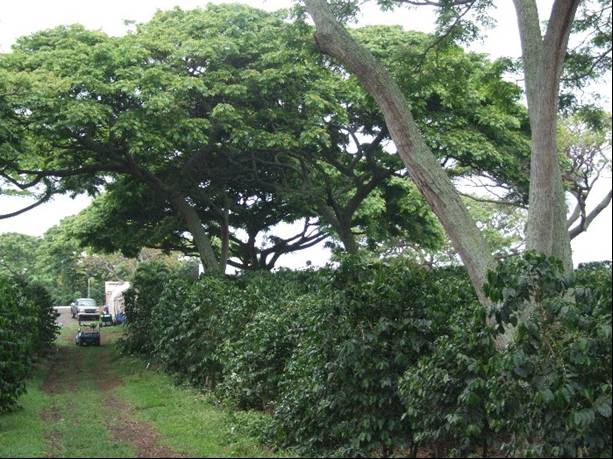Evaluation of Kona Shade Coffee Farms
Granting Agency: USDA, NRCS Conservation Innovation Grant
Program, Big Island RC&D.
Project Period: October 2007-September
2009
Principal Investigator: Craig Elevitch
Co-PIs: Travis Idol, JB
Friday, Chris Lepczyk, Virginia Easton Smith, Scot Nelson
Summary

Shade coffee systems are common in the Kona growing region, especially on small and family-owned farms, but there have been no studies to investigate how incorporation of shade trees on working farms influences the health and productivity of the coffee, what benefits the farmers perceive from their shade trees, and how shade trees may provide important ecosystem services. Our goal was to evaluate these aspects on a variety of Kona shade coffee farms.
Results
Shade levels varied widely, but yields were generally unaffected below about 50% shade. There was little relationship between tree biomass and shade, except for ohia lehua. Farms that prune lower branches or manage tree spacing are able to maintain optimal shade levels.
The C sequestered in tree biomass can be significant. In native ohia lehua forest, tree C may rival C in soil organic matter. Tree cover had no effect on soil C. At high biomass levels, there will likely be a decline in coffee yield. However, our farmers viewed coffee production under ohia as a way to help pay for preservation and restoration of native forest species.
Farmers in surveys identified a number of benefits of trees, only a few of which dealt directly with coffee health and yield. Attracting wildlife, maintaining forest cover, improving aesthetics, and creating a more pleasant work environment were among the common benefits cited. Our sampling methodology was inadequate to appropriately evaluate all these claims, but what was clear was that most of the farmers are committed to maintaining shade trees on their farms.

Publications
This work is being summarized for NRCS conservation specialists who intend to adapt current technical conservation guidelines for Hawaii. Craig Elevitch of Agroforestry Net is publishing a full-color guide based on our work.
Elevitch C, Idol T, Friday JB, Lepczyk C, Easton Smith V, Nelson SC. Shade-grown coffee for Hawaii: results of a twelve-farm study. NRCS guide. in preparation.For more information about this study, visit the project website.

